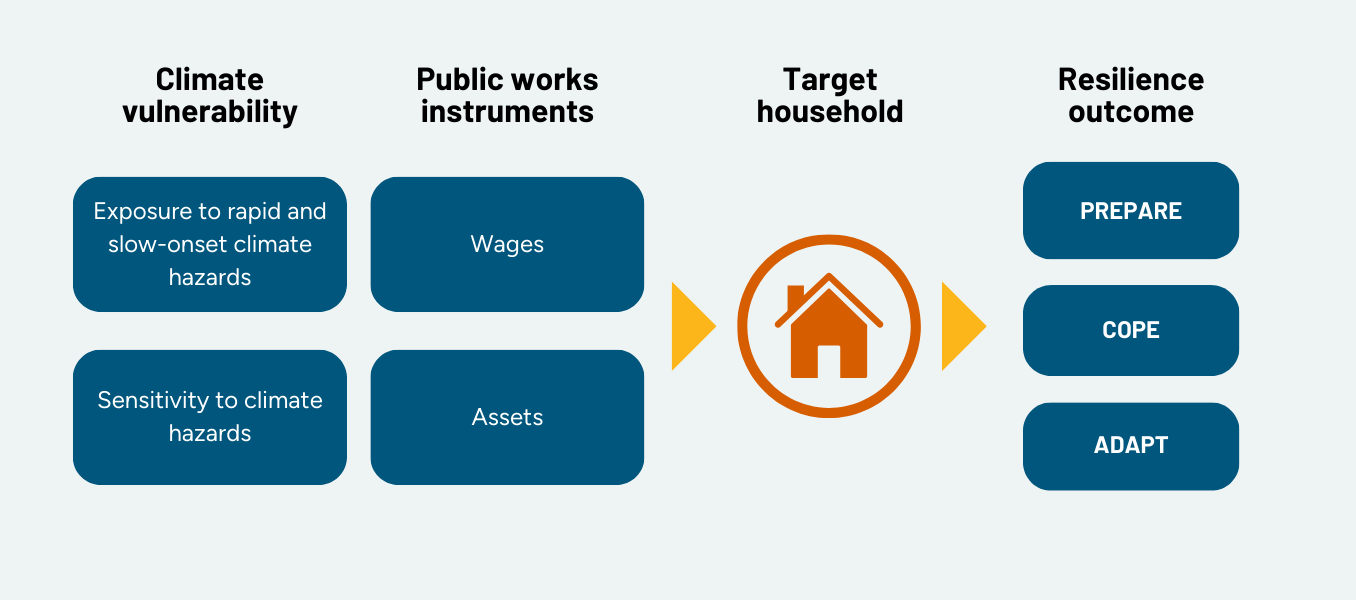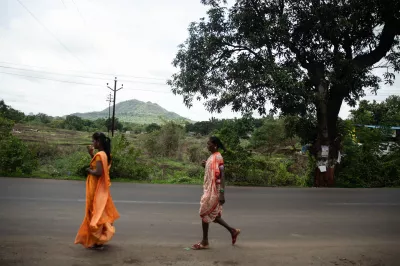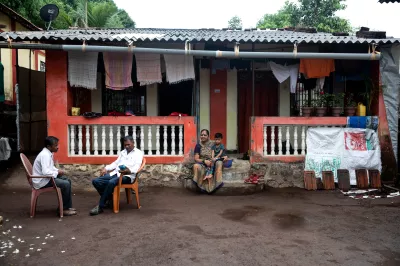Lessons From 4 Examples on the Leading Edge of Climate-Focused G2P
Climate-focused government-to-person payments that are made as part of a social protection program can increase their recipient's capacity to prepare for, cope with, and adapt to the effects of climate change - including losses from rapid-onset disasters as well as the impacts of slow-onset events.
A changing climate poses grave threats to gains in poverty reduction, with slow-onset climate changes driving multidimensional poverty and social marginalization. While government-to-person (G2P) programs designed with long-term adaptation in mind can help address these risks, well-established G2P programs with good coverage of the poorest and supportive G2P architecture are also an effective mechanism to add explicit climate change adaptation objectives. They are, in fact, already enhancing the climate change adaptation capabilities of their recipients.
Social protection programs aim to reduce poverty and vulnerability. Even without an explicit climate change adaptation objective, poverty reduction increases resilience to climate change. Below, we cite programs such as the Philippines’s 4Ps, Kenya’s HSNP, Ethiopia's PSNP and India’s MGNREGS, which were all established 15 or more years ago and have evolved to deliver climate adaptation for recipients and their households.
An economic assessment of social assistance instruments across 122 countries found social protection can enhance climate resilience, with some types of social protection appearing more effective than others. Cash transfers are the most common social safety net instrument, but they work best in countries with low climate risk. For high-risk countries, public works may be the best avenue to reach those experiencing poverty, and the most accurately targeted (i.e., effective at excluding those not living in poverty).
Alongside the more prevalent cash transfer programs, public works programs provide wages and assets to beneficiaries, both of which can support climate change adaptation. This makes them a powerful instrument for building climate change adaptation in high-risk countries.
Four examples
Ethiopia, India, Kenya, and the Philippines are at the leading edge of climate-oriented G2P programs. Two examples of social safety nets that address climate change from a disaster response angle (Philippines, Kenya) and two public works programs with an explicit focus on climate change adaptation by design (Ethiopia, India) show us how specific program design features can support greater climate adaptation for recipients and their households.
The Philippines
The Philippines’s 4Ps, a poverty reduction program established in 2008, is a good example of a social safety net scheme that addresses climate change adaptation from a disaster response angle.
Flexibility in the event of an emergency
The Department of Social Welfare and Development (DSDW), which administers the program, waives 4P program conditions for households, such as school and health centre attendance, in the event of a state of emergency. Following the 2013 disaster caused by super-typhoon Haiyan, households were able to collect their payments over the counter even though power cuts prevented the use of electronic payments for several weeks, with temporary payment points established to ensure accessibility.
Wide coverage of the social registry
The social registry’s expansive coverage (75% of the Philippine population, 21% of the population are 4Ps beneficiaries) was used by the Disaster Response Management Bureau to estimate the number of households affected by super-typhoon Haiyan given its path. DSDW coordinated data on typhoon-affected households assisted by aid agencies and enrolled an additional 20,000 households into 4Ps.
Disaster-preparedness training for recipients
The 4Ps uses its family training sessions, common to most conditional cash transfer programs, to deliver disaster preparedness information to all beneficiaries.
Partnership with the World Food Programme (WFP)
Prior to Haiyan, DSDW and the World Food Programme (WFP) began discussions regarding the use of 4Ps delivery systems for emergency payments. In response to super-typhoon Haiyan, WFP provided extra cash and rice to 105,000 affected households and reported that disbursing aid through 4Ps was faster and more cost-effective than alternative humanitarian channels.
Kenya
In Kenya, the Hunger Safety Net Program (HSNP) was established in 2008. Today, it reaches 25% of the population in the areas where it operates. The system is relatively sophisticated and well-resourced.
Ex-ante preparedness
HSNP’s early warning systems and contingency financing mechanism led to rapid responses to drought and anticipatory emergency response payments. Estimates from Kenya, Ethiopia, and Somalia suggest that when avoided losses are incorporated, early response saves USD 2.5 billion or an average of USD 163 million per year.
Scalable infrastructure
A study of four countries found that only Kenya was able to scale its social protection program coverage based on forecasts of El Niño 2015-16 because mechanisms for channelling additional funding and scaling the program to new recipients were in place before the forecasts were issued. In Malawi, Zambia, and Ethiopia, social protection systems were not ready to accommodate additional emergency recipients and were therefore unable to respond to forecasts.
Ethiopia
Ethiopia’s Productive Safety Net Program (PSNP) is an explicitly climate-oriented G2P program by design. It is a public works program that supports recipients through the provision of wages and the development of community assets. Launched in 2005 in response to persistent drought in rural areas and associated food insecurity, the PNSP boosted the integration of environmental and climate change considerations, prioritising climate resilience.
Protecting households in the short-term
An early study found that PSNP protects households from the adverse effects of climate change in the short term. The receipt of PSNP transfers was found to reduce the initial impact of drought on beneficiaries’ welfare by 57%, eliminating the adverse impact on food security within two years after a drought rather than four. However, when the value of wages is insufficient for a severe shock in PSNP, there were negative adaption strategies — a surge in natural resource extraction such as firewood collection, charcoal production, and gathering wild fruits.
Rehabilitating the environment
A later study found that PSNP increased tree cover by 3.8% between 2005 and 2019. PSNP’s watershed management assets have led to re-greening in previously arid areas and have contributed to the rehabilitation of entire community watersheds. These positive environmental impacts are enhancing agriculture productivity and livelihoods.
India
Another example of a deliberately climate-oriented public works program is India’s Mahatma Gandhi National Rural Employment Guarantee Scheme (MGNREGS). It is a key part of the country's nationally determined contribution to climate change adaptation for rural livelihood security. Established in 2008, MGNREGS guarantees 100 days paid labor to rural households, and another 50 days in times of environmental shock.
Natural resource management builds resilience
MGNREGS introduced a focus on natural resource management in 2016 to support water conservation, irrigation, and natural disaster mitigation. The creation of assets by the program is tailored to local conditions and climate risks through decentralised planning and administration. MGNREGS found that it can help build resilience to various climate shocks by providing integrated natural resource management and soil conservation infrastructure, agriculture-based investments, and other local infrastructures. A national study on the environmental impacts of MGNREGS in 2017 suggested that land and water-conserving assets created under MGNREGS contributed to an increase in farm productivity by one-third and led to an 11% increase in the income of rural households.
Helping households prepare, cope, and recover from climate change
Access to wages and assets allowed households to accumulate natural and financial capital to maintain consumption during a climate shock, but they could not save enough income for additional productive investments. A household survey in drought-affected areas in two states was commissioned to understand the 2018 drought. It found that wages helped 37% of households prepare for drought but offered minimal support for coping or recovery, while MGNREGS assets contributed more equally to households’ ability to prepare (30%), cope (28%) and recover (21%). This shows that wages alone cannot strengthen resilience to frequent and high-intensity hazards and impacts.
Figure 1: Using public works to build climate resilience (adapted from Steinbach et al 2020)

Why do social protection programs work for climate resilience?
Social Protection programs embody distinctive characteristics that make them an ideal conduit for channelling financial services to recipients. These include their vast scale, coverage of the climate affected, efficient payment delivery mechanisms, and robust organizational capabilities, all of which can significantly boost climate resilience efforts.
We believe that social protection programs - even just through payments - are already enhancing recipient climate resilience and adaptation at scale but more can be done. Over the coming year, we will investigate how, building on the inherent strengths of social protection, and financial services beyond cash transfers, can further climate resilience and adaptation objectives.
Our first blog post in this series highlighted the need for a move beyond disaster response to more consideration of climate change adaptation including to slow onset events. Our next and final blog post will consider supporting women to adapt to climate change through social safety nets.




Add new comment